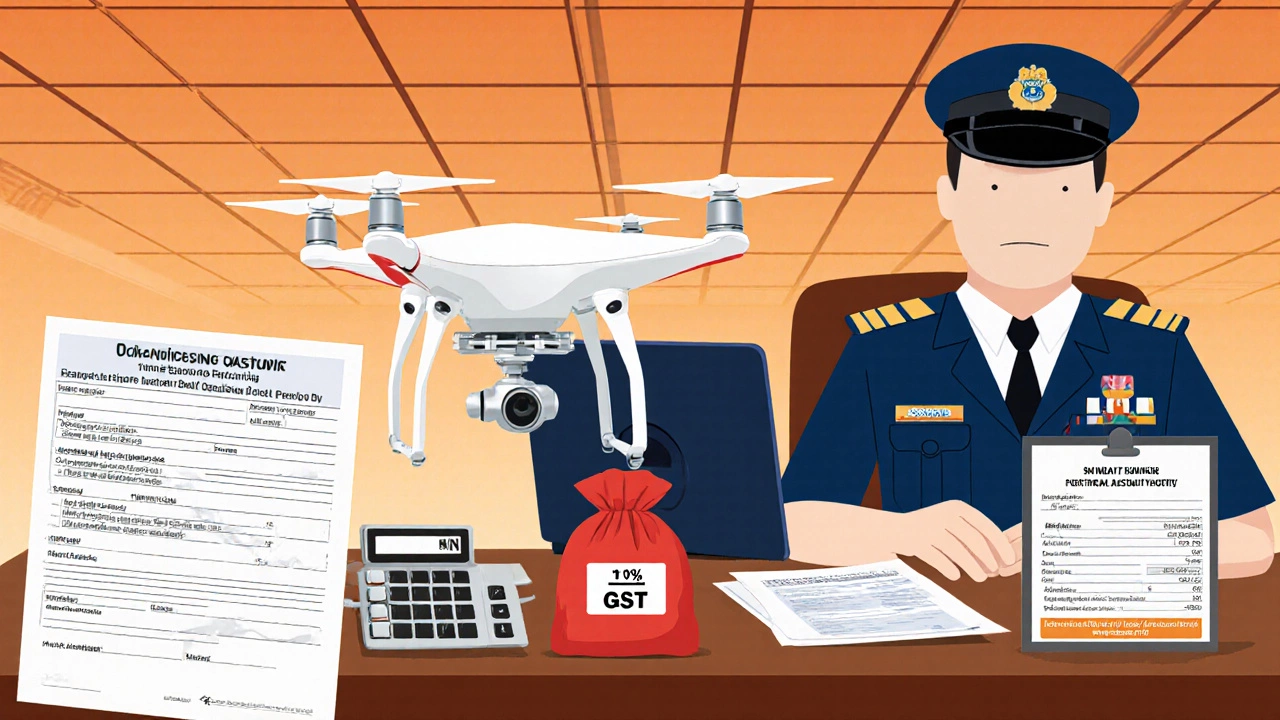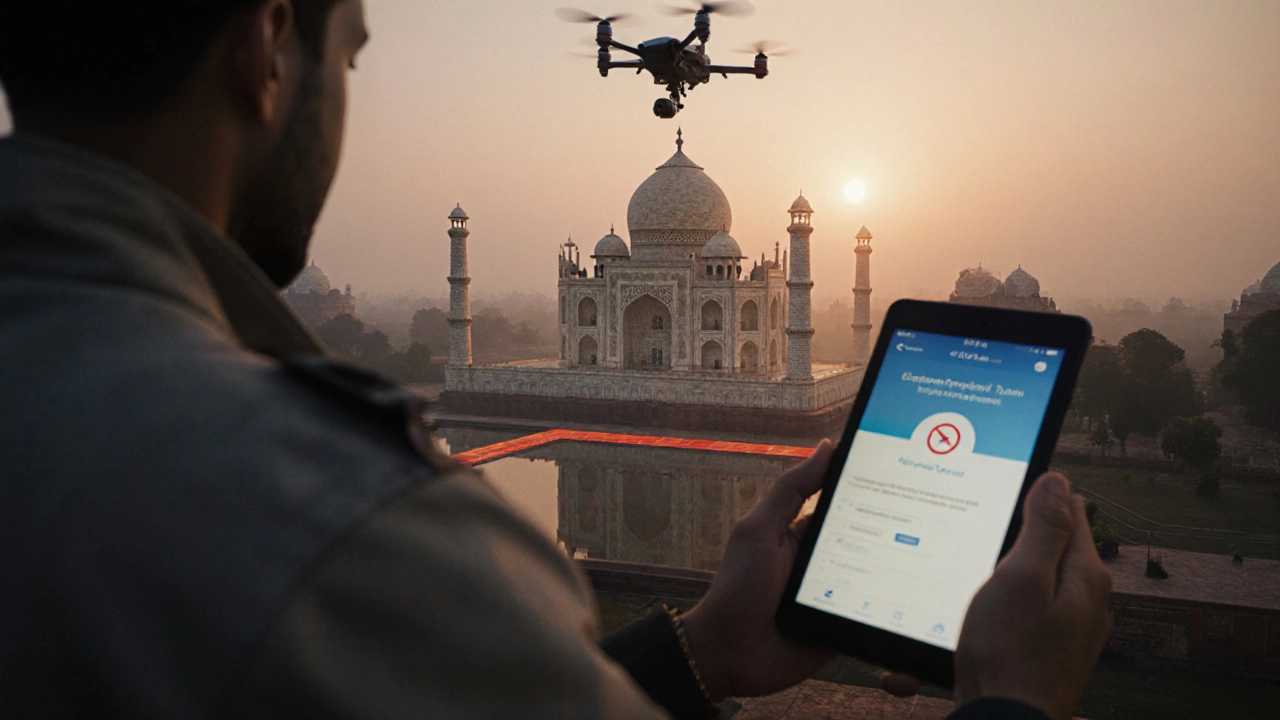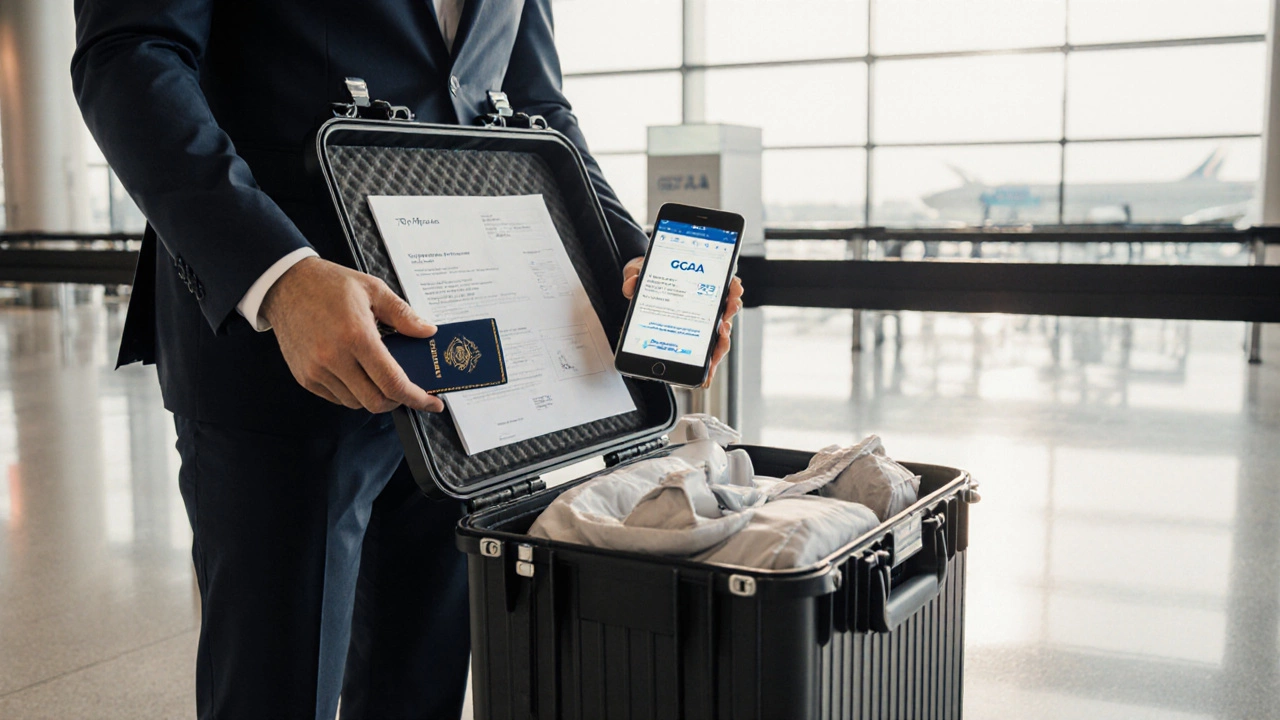Drone Import Duty Calculator
Calculate Your Drone Import Costs
Enter your drone's value in USD and weight in kg to calculate import costs. Note that:
- 10% customs duty applies to all drones
- 18% GST applies to the total value plus duty
- 5% excise duty applies for drones over 2kg
- UN 38.3 certification is required for lithium batteries
Example: A $1,500 drone (≈ INR 124,000) with 1.8kg weight:
Customs duty = INR 12,400
GST = 18% of (INR 124,000 + 12,400) = INR 23,200
Total = INR 159,600
Quick Takeaways
- Both UAE and India treat drones as controlled equipment - you need approvals before crossing borders.
- India imposes a 10% basic customs duty plus GST; larger drones may face additional excise.
- Carry the original purchase invoice, CE/IS certification, and a signed declaration of non‑commercial use.
- Lithium‑ion batteries must be packed in carry‑on bags and meet UN 38.3 test certification.
- Plan your flight path in advance - Indian airspace has strict no‑fly zones around airports, borders, and sensitive sites.
Imagine you’ve just booked a business trip from Dubai to Mumbai, and your favorite aerial camera is packed in your bag. Before you board, you wonder: Can I take a drone from Dubai to India? The answer isn’t a simple yes or no - it’s a checklist of permissions, paperwork, and safety steps that keep you on the right side of both countries’ aviation laws.
Drone is a remotely piloted aircraft that can capture photos, video, or perform surveys. In many jurisdictions, drones are classified as “aerial work platforms” and fall under civil aviation oversight. That means whenever you cross an international border, you’re moving regulated equipment, not just a consumer gadget.
Why Regulations Matter
Both the United Arab Emirates (UAE) and India have built comprehensive frameworks to manage drone operations. The goal is to protect people, property, and critical infrastructure while still allowing hobbyists and professionals to benefit from aerial imaging.
General Civil Aviation Authority (GCAA) in the UAE issues the Drone Operator Permit and maintains a digital platform called “UAE Drone Registration”. Without a valid GCAA registration, your drone cannot be legally exported or even taken out of the airport security zone.
On the Indian side, the Directorate General of Civil Aviation (DGCA) governs all civil aircraft, including drones. Since 2021, the DGCA requires every drone to be registered on the “Digital Sky” portal, and any cross‑border movement must be cleared through customs and the DGCA’s “Drone Permission System”.
Step‑by‑Step Checklist for Flying a Drone from Dubai to India
- Verify UAE Export Eligibility
- Log into the GCAA’s drone portal and confirm your aircraft is listed as “export‑ready”.
- Download the export clearance certificate - it includes the UAV’s serial number, weight class, and owner details.
- Ensure the lithium‑ion battery complies with UN 38.3 testing and has the required safety label.
- Obtain Indian Import Authorization
- Register the drone on the DGCA’s Digital Sky platform. You’ll receive a Unique Identification Number (UIN) that must be displayed on the aircraft.
- Apply for an “Import Permit for Unmanned Aerial Vehicles” through the DGCA portal. Attach the UAE export certificate, purchase invoice, and a copy of your passport.
- Pay the processing fee (approximately INR 2,500) before the permit is issued.
- Prepare Customs Documentation
- Fill out India’s Customs declaration form for electronic equipment. Include HS code 8526.91 (UAVs with camera).
- Attach the DGCA import permit, the original purchase invoice, and a CE/IS certification copy.
- Declare the value of the drone in INR; this will be the basis for duty calculation.
- Calculate Duties and Taxes
- India levies a 10% basic customs duty on drones imported for personal use.
- On top of that, GST at 18% applies to the sum of the drone’s value plus duty.
- For drones above 2 kg, an additional 5% excise duty may be charged.
- Pack Batteries Properly
- Remove batteries from the drone and place them in a fire‑resistant bag.
- Carry them in your cabin luggage - airlines prohibit lithium batteries in checked baggage unless they are under 100 Wh and approved.
- Bring the UN 38.3 test certificate to present at airline security if asked.
- Check Airline Cargo Policies
- Many carriers require a written declaration that the drone is for personal use and not for commercial transport.
- Air India and Emirates both have specific Airline Cargo Policy documents you can download.
- Reserve extra space; a compact quadcopter fits in a standard carry‑on, but larger fixed‑wing UAVs may need cargo.
- Plan Your Indian Flight Zones
- Use the DGCA’s No‑Fly Zone map to avoid restricted airspace around airports, military installations, and the India‑Pakistan border.
- Apply for a “Temporary Flight Permission” through the Digital Sky portal if you need to operate within 5 km of an airport.
- Keep the drone’s UIN visible; authorities can request to see the number during spot checks.

Comparison of Documentation Requirements: UAE vs India
| Requirement | UAE (GCAA) | India (DGCA) |
|---|---|---|
| Registration status | Export‑ready on GCAA portal | UIN assigned on Digital Sky |
| Export clearance certificate | Mandatory - includes serial number | Not required, but must match import permit |
| Import permit | N/A | DGCA approval (online) |
| Customs invoice | Purchase invoice (original) | Invoice in INR + HS code 8526.91 |
| Battery certification | UN 38.3 test report | UN 38.3 report + airline consent |
| Duty & taxes | None for export (if personal) | 10% customs duty + 18% GST (+ possible excise) |
Common Pitfalls and How to Avoid Them
Skipping the export clearance - Even if you’re only traveling, the GCAA treats the drone as an exportable item. Without the clearance, customs agents in India may seize the equipment.
Under‑declaring the value - Indian customs cross‑checks the invoice against market prices. A lowball declaration can lead to penalties or a delayed release.
Improper battery packaging - Airlines are strict about lithium‑ion cells. A melted battery in the hold can cause flight delays and possible fines.
Ignoring no‑fly zones - The DGCA’s map is updated quarterly. Flying near a newly designated restricted area can result in a hefty fine or legal action.
To stay smooth:
- Double‑check the latest GCAA and DGCA circulars - a 2024 amendment added a weight limit of 25 kg for personal drones entering India.
- Keep digital copies of every permit on your phone; a printed copy is optional but helpful during spot checks.
- If you’re unsure, consult a customs broker who specializes in electronic imports.

Best Practices for a Hassle‑Free Flight in India
- Register before you travel - The DGCA process can take 3-5 business days. Start it as soon as you book your flight.
- Use a dedicated carry‑on bag - A hard‑case backpack with a fire‑resistant liner protects the drone and batteries.
- Plan your shoot locations - Tourist spots like the Taj Mahal have their own aerial restrictions. Apply for a local permit through the state tourism board if needed.
- Carry a printed copy of the UN 38.3 certificate - Security officers often request physical proof.
- Stay within visual line of sight - Indian law still requires manual control unless you have a specific BVLOS (Beyond Visual Line Of Sight) clearance.
What If You Miss a Step?
Should you arrive in Mumbai without the proper import permit, Indian customs will typically hold the drone for up to 30 days while you arrange the paperwork. During that window, you can apply for a retroactive DGCA permission, but expect a processing fee and a possible fine of up to INR 10,000.
If the airline discovers an unsecured battery in checked luggage, the flight may be delayed, and the battery could be confiscated. In worst‑case scenarios, you’d need to repurchase a compliant battery set.
The safest route is to treat the drone as any other high‑value electronic device: declare it, secure certifications, and follow airline guidelines.
Next Steps After Landing
- Pass through customs with all documents ready.
- Submit the import permit to the DGCA officer at the customs desk.
- Pay the calculated duty and GST.
- Example: A DJI Mavic 3 priced at USD 1,650 (≈ INR 135,000). Duty = 10% → INR 13,500; GST = 18% on (INR 148,500) → INR 26,730. Total payable ≈ INR 40,230.
- Collect the cleared drone and battery pack.
- Log the UIN on the Digital Sky app and request any temporary flight permissions needed for your shoot locations.
Following this roadmap turns a potentially stressful border crossing into a straightforward process, letting you focus on capturing those stunning aerial shots of the Indian skyline.
Do I need a visa to bring my drone into India?
A visa is required for any foreign national entering India, but the drone itself does not need a separate visa. Ensure your passport and visa are valid, then focus on the DGCA import permit and customs paperwork.
Can I fly my Dubai‑registered drone in India without re‑registering?
No. Indian law requires every drone operating in its airspace to be registered on the Digital Sky portal and assigned a UIN. Even if the UAV is already registered in the UAE, you must complete the Indian registration before the first flight.
What is the maximum weight allowed for a personal drone in India?
As of 2024, drones up to 25 kg can be imported for personal use. However, any UAV heavier than 2 kg incurs an extra 5% excise duty and may need additional safety clearances.
Are there any restrictions on filming heritage sites like the Taj Mahal?
Yes. The Archaeological Survey of India designates many heritage sites as no‑fly zones. You must obtain a special permit from the ASI or the state tourism authority before conducting aerial photography at the Taj Mahal.
How long does the DGCA import permit process take?
Typically 3-5 business days if all documents are in order. During peak travel seasons, allow up to 10 days.
Can I ship my drone as cargo instead of carrying it on the plane?
Yes, but cargo shipments still require the same customs clearance, duty payment, and battery compliance. Expect longer transit times and higher handling fees.
What happens if I fly without a DGCA permit?
You risk a fine of up to INR 50,000, possible seizure of the drone, and a black‑mark on your pilot record, which can affect future permissions.




